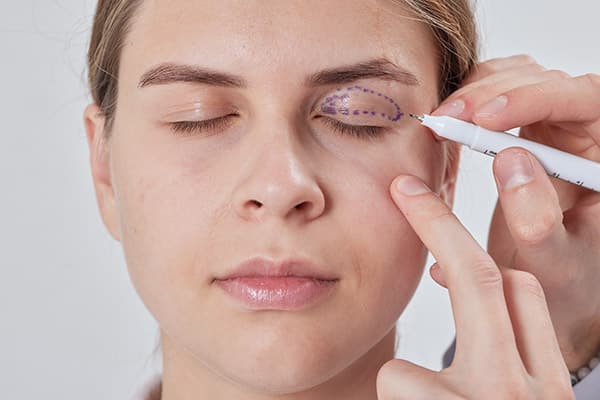Upper Eyelid Surgery

The two most commonly performed upper eyelid surgeries are blepharoplasty and ptosis repair. While the two surgeries can be performed together, they are independent and correct different problems. The distinction between the two surgeries is a source of confusion for many patients.
Upper Eyelid Surgery Miami, FL
Upper eyelid blepharoplasty otherwise known as an eyelid lift or cosmetic eyelid surgery is a procedure that removes excess skin and fat from the upper eyelids, a condition called dermatochalasis (see photos). Patients with mild dermatochalasis complain that their eyelid skin folds make their eyes look tired or smaller, or interfere with eyelid makeup. In severe cases, dermatochalasis will hang over the eyelashes and cause a “hood” over a patient’s vision. By eliminating heavy folds of skin and fat, blepharoplasty makes eyelids lighter and more visible and opens up vision. Blepharoplasty is performed under local anesthesia (numbing injections in the eyelid) with or without sedation. An incision is made in the upper eyelid skin crease and excess skin above the incision is trimmed away. Any bulging fat is also removed. The skin is closed with stitches along the original eyelid skin crease. Dr. Lee uses dissolving stitches which melt away on their own over 1-2 weeks.
After blepharoplasty, patients report lighter eyelids, more visible eyelids, more open vision, and a more youthful appearance (see photos). The incision remains hidden in the eyelid skin crease and after 6-12 months of healing the eyelids have an entirely natural appearance. If blepharoplasty is performed properly, it is very difficult, if not impossible, to see that the patient underwent any surgery. After blepharoplasty, patients frequently report acquaintances complimenting them on an improved appearance without being able to identify what has changed. Blepharoplasty may be covered by insurance if the skin folds are causing direct obstruction of central vision.
Upper Eyelid Blepharoplasty
If you are looking to have the upper eyelid surgery in Miami, give us a call for a consultation with Dr. Junhee Lee today at 305-598-2020.
Ptosis
Ptosis repair is a surgery that addresses drooping of the eyelid itself (ptosis), as opposed to the heaviness of the skin (see photos). Ptosis repair raises the eyelid by adjusting the connection between the eyelid and the muscle that lifts it (levator palpebrae superioris, or levator for short). Contrary to popular belief, the eyelid is not raised by removing skin, as this would make the eye difficult to close. Patients with ptosis complain of obstructed or hooded vision or fatigue in their eyelids. Ptosis repair is almost always performed under local anesthesia with heavy intravenous sedation. An incision is made either in the eyelid skin crease or on the undersurface of the eyelid, depending on the type and degree of ptosis. Through this incision, the connection between the eyelid and the levator muscle is shortened so that the eyelid is hanging higher from the muscle. In most patients, the surgery simply recreates the same connection that used to exist before gravity and age stretched it. Depending on the incision, stitches may need to be removed after surgery. After ptosis repair, patients report more open vision and a more alert appearance (see photos). As with blepharoplasty, it is virtually impossible to detect when a patient has undergone ptosis repair. Ptosis repair is usually covered by insurance because the eyelids are directly obstructing vision. Some patients have both ptosis and dermatochalasis and require both surgeries simultaneously.
If you or someone you love needs ptosis repair in Miami or eyelid surgery in Miami, give us a call and schedule a consultation with Dr. Junhee Lee at 305-598-2020.

